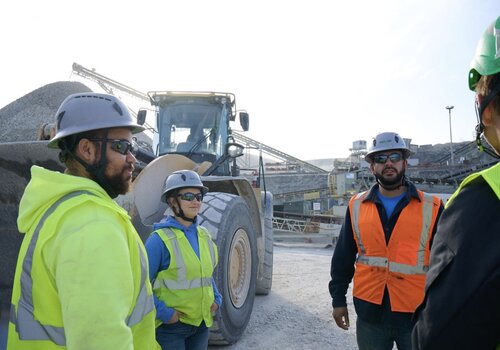The construction industry is becoming more sustainable thanks to market demands and net zero initiatives. Contractors who want to stay competitive need to understand Whole Building Life Cycle Assessment (LCA), a comprehensive approach that evaluates the environmental impacts of a building over its entire lifespan, from raw material extraction to demolition and disposal. LCA is an indispensable tool for construction contractors in a changing market.
WHAT IS WHOLE BUILDING LIFE CYCLE ASSESSMENT (LCA)?
LCA is a methodical analysis that assesses the environmental impacts associated with all stages of a building's life. This includes the extraction of raw materials, manufacturing, transportation, construction, use, maintenance and end-of-life phases. By considering all these stages together at once time, LCA provides a holistic view of a building’s environmental footprint, which can inform sustainable design and construction practices.
The assessment typically involves the following four steps:
- Goal and Scope Definition: Determining the purpose of the LCA, the boundaries of the study and the specific environmental impacts to be assessed.
- Inventory Analysis: Collecting data on energy and material inputs and environmental releases for each life cycle stage.
- Impact Assessment: Evaluating the potential environmental impacts based on the inventory data.
- Interpretation: Analyzing the results to make informed decisions and recommendations.
WHY IS LCA IMPORTANT?
Environmental Responsibility: The global construction industry is a significant contributor of greenhouse gases with 37% of global emissions. LCA helps in identifying areas where improvements can be made to reduce carbon emissions, energy consumption and waste generation.
Regulatory Compliance: Increasingly, regulations and certifications, such as LEED (Leadership in Energy and Environmental Design), are requiring or encouraging LCA as part of the sustainability assessment.
Economic Efficiency: By understanding the full life cycle costs and impacts, contractors can identify more sustainable and cost-effective solutions, reducing long-term operational costs.
Market Competitiveness: Demonstrating a commitment to sustainability through LCA can enhance a company’s reputation and attract environmentally conscious clients. As the world works to reduce emissions, the market for construction, materials, equipment and operations could grow an estimated 38 percent by 2030 and reshape the competitive landscape in favor of those who are already focused on LCA.
Many cities, counties and even a few states have adopted mandatory building energy benchmarking and transparency policies for existing buildings.
HOW TO GET STARTED WITH LCA
Starting with LCA can seem daunting, but the process can be streamlined by following five steps:
- Educate and Train: Familiarize yourself and your team with the principles of LCA. There are numerous resources, courses and certifications available online.
- Software Tools: Utilize LCA software tools such as SimaPro, GaBi or One Click LCA, which can simplify data collection and analysis. The Athena Impact Estimator for Buildings is a free LCA software tool that offers a great way to get started.
- Data Collection: Gather detailed data on materials, energy use and emissions. Accurate data is critical for a reliable assessment. While LCA requires a tremendous amount of data, the most important first step is to get started. Experts hope to develop a uniform database platform for LCA.
- Set Clear Objectives: Define the goals of your LCA. Are you aiming to achieve a specific certification, reduce your environmental footprint or comply with regulations? Try testing a past project to see what you may have missed or needed more information to get the desired results. Use those findings to better prepare for your next project or before applying for a certification.
- Consult Experts: Seek assistance from LCA consultants who can provide expertise and ensure the accuracy and relevance of your assessment. California has become the first state to address embodied carbon in a mandatory code and offers a variety of resources and factsheets.
BENEFITS OF IMPLEMENTING LCA
The implementation of LCA offers numerous benefits to construction contractors. Adopting LCA can help not only the environment but also your bottom line and decision-making process on a project.
- Enhanced Sustainability: By identifying and mitigating the most significant environmental impacts, LCA helps in creating more sustainable buildings.
- Cost Savings: Identifying opportunities for using less resource-intensive materials and processes can lead to significant cost savings over the building's life cycle.
- Informed Decision-Making: LCA provides a robust framework for making informed decisions about materials, design and construction practices.
- Improved Building Performance: Sustainable design often results in buildings that are more energy-efficient and comfortable for occupants.
- Compliance and Certification: Achieving certifications such as LEED or BREEAM can provide a competitive advantage and meet regulatory requirements.
FUTURE TRENDS IN LCA
As the construction industry continues to evolve, several trends are shaping the future of LCA.
Integration with BIM: Building Information Modeling (BIM) is becoming more integrated with LCA tools, enabling real-time environmental impact assessments during the design phase.
Advancements in Materials: The development of new, sustainable materials with lower environmental footprints will continue to drive the need for comprehensive LCA to validate their benefits.
Regulatory Pressure: Governments worldwide are increasingly mandating environmental assessments, including LCA, to ensure sustainable construction practices. The U.S. Department of Energy has a goal for net zero building by 2050, with a blueprint for the building sector to reduce emissions. The Biden administration has invested $2 billion in 150 federal building projects using low-carbon materials to combat climate change through government purchasing power.
Digital Twins: The use of digital twins, which are virtual replicas of physical buildings, allows for ongoing performance monitoring and optimization, further enhancing the value of LCA.
Increased Awareness and Demand: As stakeholders become more aware of the importance of sustainability in construction, the demand for buildings assessed through LCA will grow, pushing the industry towards more environmentally responsible practices. Many cities, counties and even a few states have adopted mandatory building energy benchmarking and transparency policies for existing buildings.
By understanding and implementing LCA, contractors can significantly reduce the environmental impacts of their projects. As the industry moves towards greater sustainability, those who adopt LCA practices will be well-positioned to lead in the market, providing value not only to their clients but also to the planet.
Photo credit: FANTASTIQUE/BIGSTOCKPHOTO.COM












